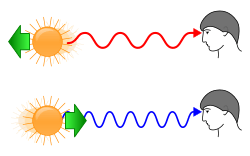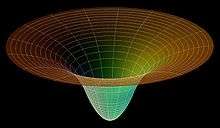Blueshift
A blueshift is any decrease in wavelength (increase in energy), with a corresponding increase in frequency, of an electromagnetic wave; the opposite effect is referred to as redshift. In visible light, this shifts the color from the red end of the spectrum to the blue end.
Doppler blueshift

Doppler blueshift is caused by movement of a source towards the observer. The term applies to any decrease in wavelength and increase in frequency caused by relative motion, even outside the visible spectrum. Only objects moving at near-relativistic speeds toward the observer are noticeably bluer to the naked eye, but the wavelength of any reflected or emitted photon or other particle is shortened in the direction of travel.[1]
Doppler blueshift is used in astronomy to determine relative motion:
- The Andromeda Galaxy is moving toward our own Milky Way galaxy within the Local Group; thus, when observed from Earth, its light is undergoing a blueshift.
- Components of a binary star system will be blueshifted when moving towards Earth
- When observing spiral galaxies, the side spinning toward us will have a slight blueshift relative to the side spinning away from us (see Tully–Fisher relation).
- Blazars are known to propel relativistic jets toward us, emitting synchrotron radiation and bremsstrahlung that appears blueshifted.
- Nearby stars such as Barnard's Star are moving toward us, resulting in a very small blueshift.
- Doppler blueshift of distant objects with a high z can be subtracted from the much larger cosmological redshift to determine relative motion in the expanding universe.[2]
Gravitational blueshift

Unlike the relative Doppler blueshift, caused by movement of a source towards the observer and thus dependent on the received angle of the photon, gravitational blueshift is absolute and does not depend on the received angle of the photon:
Photons climbing out of a gravitating object become less energetic. This loss of energy is known as a "redshifting", as photons in the visible spectrum would appear more red. Similarly, photons falling into a gravitational field become more energetic and exhibit a blueshifting. ... Note that the magnitude of the redshifting (blueshifting) effect is not a function of the emitted angle or the received angle of the photon—it depends only on how far radially the photon had to climb out of (fall into) the potential well.[3][4]
It is a natural consequence of conservation of energy and mass–energy equivalence, and was confirmed experimentally in 1959 with the Pound–Rebka experiment. Gravitational blueshift contributes to cosmic microwave background (CMB) anisotropy via the Sachs–Wolfe effect: when a gravitational well evolves while a photon is passing, the amount of blueshift on approach will differ from the amount of gravitational redshift as it leaves the region.[5]
Cosmological blueshift
In a hypothetical universe undergoing a runaway Big Crunch contraction, a cosmological blueshift would be observed, with galaxies further away being increasingly blueshifted—the exact opposite of the actually observed cosmological redshift in the present expanding universe.
Notes
- Kuhn, Karl F.; Theo Koupelis (2004). In Quest of the Universe. Jones & Bartlett Publishers. pp. 122–3. ISBN 978-0-7637-0810-8.
- Aoki, Kentaro; Toshihiro Kawaguchi; Kouji Ohta (January 2005). "The Largest Blueshifts of the [O III] Emission Line in Two Narrow-Line Quasars". Astrophysical Journal. 618 (2): 601–608. arXiv:astro-ph/0409546. Bibcode:2005ApJ...618..601A. doi:10.1086/426075.
- R.J. Nemiroff (1993). "Gravitational Principles and Mathematics". NASA.
- R.J. Nemiroff (1993). "Visual distortions near a neutron star and black hole". American Journal of Physics. 61 (7): 619–632. arXiv:astro-ph/9312003v1. Bibcode:1993AmJPh..61..619N. doi:10.1119/1.17224.
- Bonometto, Silvio; Gorini, Vittorio; Moschella, Ugo (2002). Modern Cosmology. CRC Press. ISBN 978-0-7503-0810-6.